The Tragedy of Vessel, Staircase to Nowhere
Have you heard about Vessel? It’s a giant climbable sculpture at the center of Hudson Yards, the $25 billion real estate development that masquerades as a neighborhood in the far west-side of midtown Manhattan, New York City. The creation and demise of Vessel is a cautionary tale on the foibles of contemporary art, but it’s also a metaphor for the crisis of American urbanism, and how media passes off unworthy works and individuals as impressive and noteworthy. Vessel is the zeitgeist of postmodern art. Allow me to fill in the details.

The Hudson Yards Redevelopment Project is the brainchild of New York real estate firm The Related Companies. Founded by billionaire Stephen M. Ross, the firm became an inexorable force in developing commercial properties. Hudson Yards is a city unto itself, but it should remind readers of the dystopian story The Hunger Games, where a class of frivolous and diversion obsessed elites attempted to rule over a ruined and fragmented society.
The official opening of Hudson Yards and Vessel took place on March 15, 2019. CNN’s pretend journalist Anderson Cooper moderated the affair. Democrat Senator Chuck Schumer gave a frothy speech, and then Big Bird the anthropomorphic muppet joined with Cooper, Stephen M. Ross, Sen. Schumer, and Thomas Heatherwick (designer of the gigantic staircase to nowhere), to launch Vessel in a flurry of confetti. A gospel choir sang out praises, and the Alvin Ailey American Dance Theatre performed. It was all quite the spectacle, and no one had a clue what awaited them.
The 28-acre Hudson Yards complex is a huge gentrification project that hopes to transform an aging neighborhood into an exclusive enclave for the affluent. In part it offers 16 imposing skyscrapers with classy office space for some 55,000 employees, plus posh apartments and condos for 5,000 au courant swells (apartments go for $9,000 a month and condos start at $2 million). There is an arts center named The Shed for swanks like you, innumerable chic boutiques, cafes, bars, restaurants, an exclusive hotel, plus “public space” and gardens for the voguish to stroll through… et cetera, et cetera. But the center of Hudson Yards is its massive “public square” where Vessel dominates.
The Related Companies felt a bona fide tourist attraction was needed to draw happy shoppers into their Hudson Yards consumer paradise and real estate scheme. You know, a special touch to put a human face on the commercial development, investing in the “public space” and all that. It was essential for the attraction to offer, or at least appear to offer, something for the city’s goldbricks, clock-watchers, and proles to unite around. An iconic object to inspire unlimited selfies and generate free advertising to attract customers like moths to a flame. Enter the celebrated English postmodern designer and architect, Thomas Heatherwick.
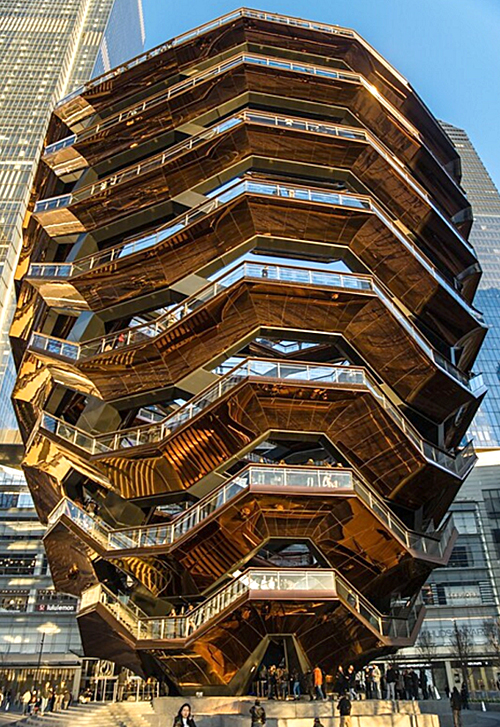
Heatherwick was commissioned to create the attraction, and he delivered Vessel, an eight level, sixteen-stories high, tangled labyrinth of 154 connected staircases with eighty landings and 2,500 steps that go nowhere.
The 150-foot-tall structure was envisioned as an immersive design experience where people would socialize while getting a bird’s eye view of the megalopolis. The armature of Vessel is concrete covered with copper-colored steel.
But all of Vessel’s 75 enormous pre-fabricated steel pieces were fabricated in Italy because the miracle of globalism has nearly shut down America’s steel industry. Starting at its base Vessel is 50 feet across, and floor by floor it expands in width until it becomes 150 feet wide at its top level.
Vessel became an irresistible backdrop for selfies, but more than a few detractors rechristened it “the pineapple,” “beehive,” “wastepaper basket,” “pinecone,” “rat’s nest,” “Chalice of the Privileged,” “giant shawarma,” and other ill-favored nicknames.

Personally I think it looks like the extinct marine arthropod known as the Trilobite. Some pretentious artsy-fartsy types said it looked like one of those impossible staircases by Dutch artist M.C. Escher (1898-1972). I am certain that suggestion would have displeased Escher.
I discovered Escher as a pre-teen and fell in love with his lithographs, woodcuts, and mezzotint prints. I studied them not for their impossible perspectives but for their technique and off-kilter realism. He inflamed my passion for printmaking. Escher considered himself not an artist but a mathematician. It speaks volumes that the art world basically ignored him his entire life; his first retrospective came when he was 70-years old (he would die at age 73). Who will Thomas Heatherwick inspire? Certainly not me.
Heatherwick’s whimsical joke of a building cost $200 million to construct, but no one is laughing. I realize pseudo-intellectuals and the terminally trendy say he is the new Leonardo da Vinci of design, but few noticed Leonardo’s Vessel had, shall we say… design flaws. For instance, those damnable stairs.
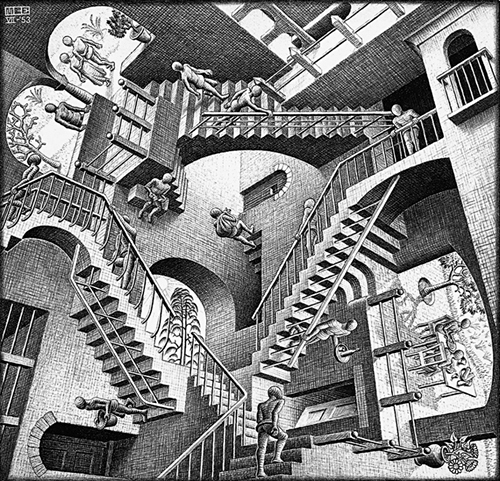
I was privileged to visit Notre Dame Cathedral in Paris, France before some idiot burned it down. Since medievalist engineers did not equip churches with elevators, I climbed up and down its stone steps to visit the rooftop gargoyles; those 774 steps were a real workout.
I visited the Cologne Cathedral in Germany, it was exhausting to climb up and down its 1,066 rough hewn steps to gain access to the rooftop view of the city. It goes without saying that the history of those two Cathedrals was more than awe inspiring.
Now imagine the Vessel’s labyrinth of 2,500 steps, and the herculean task of climbing all 5,000 to go up and down this “interactive” cardio nightmare of a sculpture. What is the point of all that marching up and down? Heatherwick must surely despise the elderly. Worse, the structure offers not a single bench or place to sit, and its one tiny elevator is exclusively for people with disabilities; nonetheless, the elevator only stops on floors 5, 7, and 8.
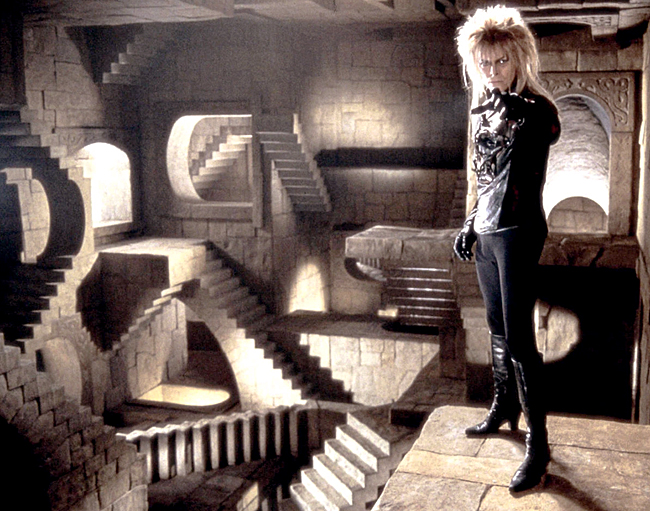
Climbing Notre Dame Cathedral and Cologne Cathedral were well worth the effort, but the giant shawarma? I have visited authentic tourist attractions around the world, places like the Maya ruins of Chichen Itza in Yucatán, Mexico, the ancient Roman Colosseum in Rome, Italy, and the 17th century home of American patriot Paul Revere in Boston, Massachusetts.
These and other attractions I sojourned to are steeped in history and meaning; they are stirring points of interest. But what profundity does Vessel extend, aside from being a backdrop for smartphone photos?
However, Vessel has a much bigger problem than its steps. It is cursed by its railings. They are only 4-feet-high, even at its 150-foot-high eighth level. They are low enough for your average teen or adult to jump over—and jump they did.
The first suicide took place in Feb. 2020, when a 19-year-old man leapt from the Vessel’s uppermost deck. The second suicide occurred in Dec. 2020 when a 24-year-old woman also hopped over the railings at the eighth-floor to meet her demise. The third suicide happened in Jan. 2021 when a 21-year-old-man on the eighth-floor bounded over the railings to his death.
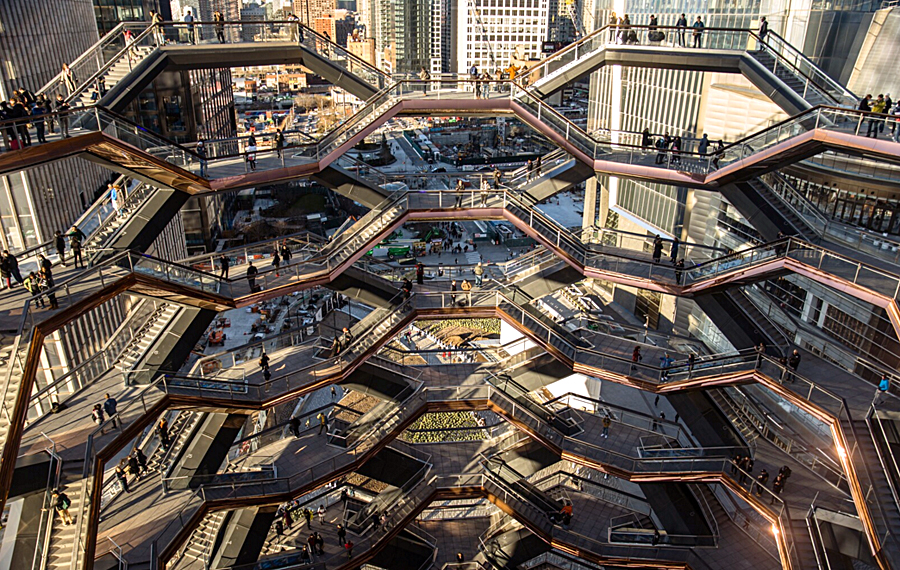
A day after the third suicide Vessel was closed to the public so that “safety measures” could be instituted to prevent further deaths. Suicide prevention signs were mounted on the building and affixed to the railings. More security personnel were hired. Visitors were banned from entering Vessel alone, and though entry was once free visitants now had to pay a $10 entry fee (as if paying admission would prevent suicide). The National Suicide Prevention Hotline number was printed on the admission tickets. Everything was done to insure safety… except for raising the height of the railings, which is something The Related Companies refused to do, despite pleas from suicide prevention specialists. A “safer” Vessel reopened on May 28, 2021.
On July 29, 2021, a 14-year-old boy jumped to his death from the top floor of Vessel. That same day the building was closed, perhaps forevermore.
So there you have it, all that effort come to naught. London’s Royal College of Art (RCA), educated Thomas Heatherwick. That institute also boasts Tracey Emin and Jake and Dinos Chapman as alumni. How can a prestigious institution of art and design like the RCA cultivate, encourage, and champion such charlatans? It’s simple really. Postmodernist dogma with its aesthetics of ugly, superficial, kitsch, reigns supreme in universities and art academies; museums, galleries, and art critics are also spellbound by the doctrine. Critiques of Heatherwick and his postmodern cohorts are negligible because they are favored by the ruling elites. Even though Vessel has proven to be a literal deathtrap, its designer is viewed as blameless. The art world reaps what it sows.
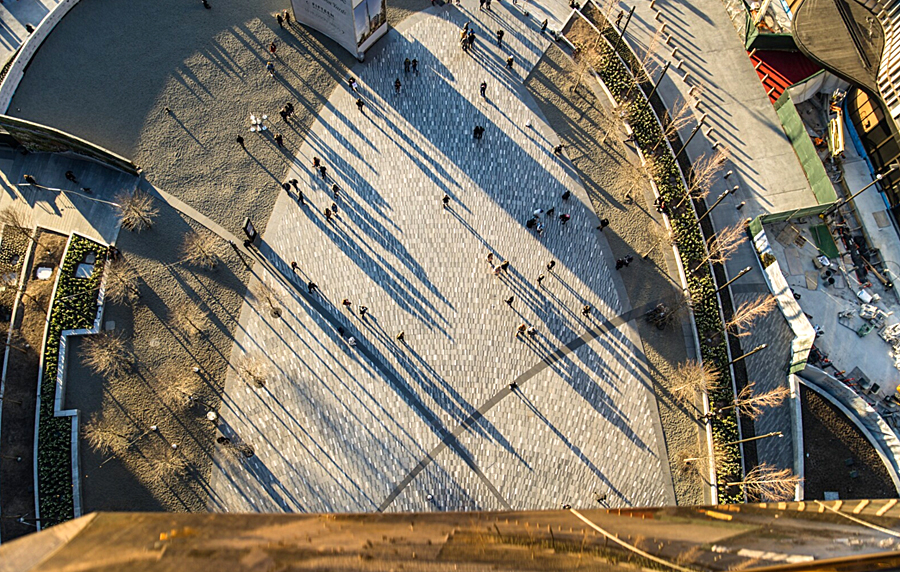
One of the quagmires facing the contemporary art world—with its steady stream of horrid, silly, incomprehensible, and frightfully expensive thingamajigs, is its having become contemptuous of the public. Witness those workday-world New Yorkers who mocked Vessel as a “wastepaper basket,” “rat’s nest,” and “Chalice of the Privileged.” They were ignored by sophisticates who regarded them as uncultivated and artless. The corps d’elite simply doubled down on their Vessel nonsense. And the big payoff? Four tragic suicides, traumatized families, the $200 million Vessel closed indefinitely, and calls for it to be torn down.
I do not write the following to cast aspersions on the Alvin Ailey American Dance Theatre, but since they promoted Vessel in a video and performed at its official opening they are open to critique. I had the pleasure of seeing them perform in Los Angeles years ago, and it is widely acknowledged the troupe has had an impact on modern dance. Still, I found their Vessel promo film to be regretful.
For the task of glorifying Vessel the dance company abandoned their autonomy and took money from The Related Companies, the multi-billion dollar real estate firm behind Vessel’s creation. The firm hired visual effects studio MILL+ to produce the Alvin Ailey film. The effects studio specializes in producing “immersive experiences” for entertainment franchises and product promotions. I hate to break it to the dance troupe but this is not art, it’s advertising. Related Companies has left its imprimatur on the legacy of the Alvin Ailey American Dance Theatre, and that’s a shame.
The MILL+ production with the Alvin Ailey troupe is titled The Film, and it opens with a morning scene in New York City. Troupe members are shown dancing their way through the cosmopolis; they undulate over cobblestone streets, and with fluid free-style steps glide through the subway, leaping up stairs and down avenues on a journey to an unknown destination. Eyes lift from sidewalks to tall buildings to see strange shadows of the climbable sculpture cast upon the edifices. Reaching Hudson Yards the group dances triumphantly; presumably they are dancing at the feet of the gigantic Vessel, even though it is never seen. In the final frames the troupe is observed from above gathered in a loose circle, arms thrust skyward as if in spiritual exaltation. Their bodies cast a growing shadow, the eerie penumbra taking on the shape of the Vessel.

Though not shown in the video, all I could see were ghostlike figures jumping from the top of the shadowy Vessel, they were leaping into suicidal oblivion. That is what the Vessel has become… a grave marker for postmodernism.
None of this comes as a surprise, I have long felt darkness was falling over the art world. I was 19-years-old in 1972 when an unfamiliar character named Christo spent $700,000 hanging orange nylon fabric across Rifle Gap in Colorado. It wasn’t the first time I despaired for art, and it wouldn’t be the last. I felt the gloom when wrecking cranes destroyed the Los Angeles County Museum of Art in 2020-2021, and when mobs began defacing and pulling down historic classical sculptures in public places during the summer of 2020 and beyond. Graffiti finding a home in art museums didn’t help any. But the implosion of Vessel was the last straw, it was akin to watching the final curtain coming down on the theater of postmodernism—and there was no applause.
It is said “art is a reflection of society,” but who shapes society? The people of NYC didn’t ask for a $200 million “wastepaper basket,” it was imposed upon them by a giant real estate firm and the city’s ruling Democrats. Society, such as it is, had nothing to do with it. But then again… New York City’s newly elected Mayor Eric Adams (D) approved legislation in January 2022 giving nearly a million non-citizens the right to vote in city elections. And the just elected District Attorney for Manhattan, Alvin Bragg (D), has downgraded armed robbery to a misdemeanor, making it a non-jailable offense. And that is why the city is called Gotham.
Perhaps Heatherwick’s $200 million “rat’s nest” really is the appropriate icon for New York City. As the Rolling Stones sang in their 1978 song titled Shattered, “Go ahead, bite the Big Apple, don’t mind the maggots.”



